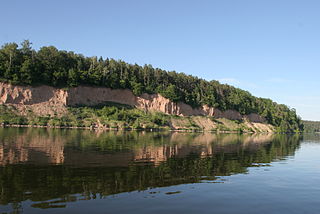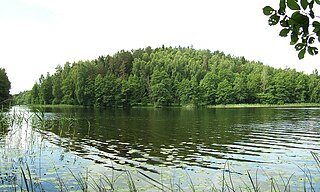Lithuania has 30 regional parks and 1 protected landscape and 1 cultural reserve. All under V IUCN protected area category. [1] Law on establishing regional parks took effect in 1992. [2]

A nature reserve is a protected area of importance for flora, fauna, or features of geological or other special interest, which is reserved and managed for purposes of conservation and to provide special opportunities for study or research. They may be designated by government institutions in some countries, or by private landowners, such as charities and research institutions. Nature reserves fall into different IUCN categories depending on the level of protection afforded by local laws. Normally it is more strictly protected than a nature park. Various jurisdictions may use other terminology, such as ecological protection area or private protected area in legislation and in official titles of the reserves.
A regional park is an area of land preserved on account of its natural beauty, historic interest, recreational use or other reason, and under the administration of a form of local government.
Greece is characterized by an extremely fragmented, rugged landscape hosting a great diversity of ecosystems and an outstanding biodiversity. Almost 5% of its extensive coastline consists of ecologically sensitive wetlands. Two thirds of the total population live no further than 2 km from the coast and most of the important urban centers are coastal, while almost all of the tourist infrastructure is divided among islands and the coastal mainland.
Nullarbor Regional Reserve is a protected area in South Australia located about 300 kilometres west of Ceduna.

Kauno Marios Regional Park was established in 1992 with the purpose to protect the unique lower landscape of Kaunas Reservoir, its natural ecosystem, and cultural heritage. It covers the total of 101.73 km² and is one of the 30 regional parks in Lithuania.

Rambynas Regional Park is one of the Regional Parks in Lithuania, situated at Pagėgiai municipality on the right Nemunas river bend in Lithuanian Republic near the border of Kaliningrad Oblast. The park was founded in 1992 with its area of 4,786 ha.
... Life is a constant movement. A Wide variety of different forms emerge and disappear... Over the thousand years, stones grow and decay. Life explodes, animals and people are born and so lost... These days, people learn how to look at nature at more calmed glance. And life effects are clearly visible in a strong relationship with nature as if the person opens the whole mystery of nature, all of the Mysteries...
A nature park, or sometimes natural park, is a designation for a protected natural area by means of long-term land planning, sustainable resource management and limitation of agricultural and real estate developments. These valuable landscapes are preserved in their present ecological state and promoted for ecotourism purposes.

Kuršių Nerija National Park is one of the five national parks in Lithuania. It was established in 1991 to protect the unique ecosystems of the Curonian Spit and Curonian Lagoon.

Dubysa, at 131 km, is the 15th longest river solely in Lithuania. It originates just a few kilometers from Lake Rėkyva near Šiauliai city. At first it flows south, but at Lyduvėnai turns southeast and near Ariogala - southwest. Dubysa is a Samogitian river. The first few kilometres of Dybysa are also known as Genupis or Šventupis.

There are several types of protected areas of the Czech Republic. The main form of landscape protection is delimitation of special protected areas. All the types of protected areas are determined by law.

Protected areas of Russia,, is governed by the corresponding 1995 law of the Russian Federation.
Protected areas of Estonia are regulated by the Nature Conservation Act, which was passed by the Estonian parliament on April 21, 2004 and entered into force May 10, 2004. Overall Estonia has 15403 Protected Areas covering 21.21% of the country land and 18.78% of it marine and coastal territory.
The Protected areas of Portugal are classified under a legal protection statute that allows for the adequate protection and maintenance of biodiversity, while providing services for ecosystem that maintains the natural and geological patrimony.

Labanoras Regional Park, established in 1992, is located 80 kilometers northeast of Lithuania's capital, Vilnius. Covering 553.18 km², it is the largest regional park in the country.
Georgia has a long history of establishing Protected Areas dating back to 1912 when the Lagodekhi Strict Nature Reserve was created. Nowadays, protected areas make up to 7% of the country's territory and about 75% of protected areas are covered by forests. Total number of protected areas in Georgia — 89. In Georgia there are 14 Strict Nature Reserves, 12 National Parks, 20 Managed Nature Reserves, 40 Natural Monuments, 2 Ramsar sites and 1 Protected Landscape. Management and coordination of the Protected Areas is implemented by a Legal Entity of Public Law Protected Areas Agency of the Ministry of Environment Protection and Natural Resources of Georgia. Currently under development:
Protected areas of Ukraine are special areas of Ukraine established with the goal of protecting the natural and cultural heritage of the country from excessive changes as a result of human activity. The protection of the areas is the responsibility of the government of Ukraine, specifically the Cabinet of Ministers of Ukraine.
Categories of Natural Environment Protected Areas of Ukraine were reestablished (redefined) by the national parliament of Ukraine after the fall of the Soviet Union. On June 16, 1992 the President of Ukraine Leonid Kravchuk signed the law on the Nature-Preservation Fund of Ukraine. The law redefined already the established system of environment protection management for Ukraine as a fully sovereign and independent country. National Parks in Ukraine and other Protected Areas of Ukraine include Ramsar Sites in Ukraine, *Biosphere Preserves of Ukraine, National Nature Parks of Ukraine, Nature Preserves of Ukraine, Regional landscape parks of Ukraine, Nature monuments of Ukraine, Protected tracts of Ukraine and Habitat / Species Managed Areas of Ukraine.
The Yellabinna Regional Reserve is a protected area in the Australian state of South Australia located about 30 kilometres north of Ceduna. To the west it borders Nullarbor Regional Reserve, to the south Yumbarra Conservation Park and Pureba Conservation Park. In the northwestern Section the 5,030 km2 Yellabinna Wilderness Protection Area (YWPA) is almost entirely surrounded by the Regional Reserve. The northern border in the western half of the reserve is formed by the Trans-Australian Railway.

Dūkštos Eldership is an eldership in Lithuania, located in Vilnius District Municipality, east of Vilnius.